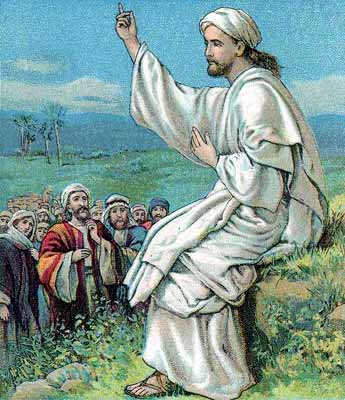Storytelling Demonstration: The Good Samaritan
This teacher training workshop can be adapted for classroom use.
Let’s look at one of the most dramatic stories in Western tradition and see if we can identify what makes a story more powerful than a concept. Then we will use what we have learned to create a modern day story that parallels the parable of The Good Samaritan. This exercise will give us a model we can use when composing other teaching stories that parallel a bible story.
Storytelling As A Teaching Method
Storytelling is the most effective teaching method because stories entertain as well as educate. Religion textbooks sometimes include stories, but often they are bare-bones stories that fail to create vivid pictures in the mind. Sometimes the student text offers only a series of concepts. Either way, the lesson is dull, so it is up to the teacher to either fix the given story or create a new one full of dramatic images.
Story Of The Lost Children
The story of Hansel and Gretel was developed centuries ago in Germany in a village near the Black Forest where parents were constantly searching for lost boys and girls. The forest was named the Black Forest because the trees were so thick it was too dark to see more than a few feet. This was a dangerous place full of bad people and hungry wolves who hid in the underbrush, where they awaited their victims.
When children were old enough to play outside, at first the moms probably said, “Don’t go near the forest. It’s dangerous.” This statement is a concept–an abstract idea–so the words went in one ear and out the other.
Next, the dads warned, “If you go near the forest, you can’t have any dessert.” There you have a visual image that is close to a good story. The children could picture themselves staring into an empty bowl while everyone else at the table enjoyed their pudding. But, was it a powerful enough image to control behavior for many years? Apparently not, because children continued to disappear.
Grandpa To The Rescue
One evening a wise grandpa, who was a good storyteller, showed the way. After dinner he invited his grandchildren to sit next to him by the fireplace and listen to a story. He spun the tale of a boy and girl who wandered into the forest. There, they met a wicked witch, who captured them. And what did she do with them? SHE BOILED THEM AND ATE THEM.
What made Grandpa’s story powerful?
The concept, ‘the forest is dangerous,’ was illustrated using vivid imagery. This story was an effective teaching method because it gave such frightening mental pictures of Hansel and Gretel’s fate in the forest that the other children changed their behavior.
Stories that arouse strong emotions are the best teaching method for a religion teachers because the strong emotions change the students’ brain chemistry. This causes their minds to be more suggestible than usual. Lessons are learned more easily and are more permanently etched into their memories.
How To Develop A Good Story
Some teachers are natural spinners of tales, but for those of us who need help to become a good storyteller, there is a basic formula to follow. Aim to make your story emotional. Strive to stimulate feelings, such as, comfort, fright, sorrow, excitement or inspiration.
Present your story as a scene or a series of scenes. There are eight elements to a scene and all eight must be employed.
- Describe the place.
- Name the hero.
- Tag the hero with some identification (clothing, attitude, etc.).
- Start the action. Use dialog.
- Introduce a villain or an opposing force.
- Establish conflict. Use dialog.
- Resolve the conflict.
- Close the scene. Describe how the hero feels about what happened. Or, show what the hero does in response to what happened.
When you use all eight elements, the story achieves its full impact because each element makes the story come alive in a different way. If you are “fixing” a dull story in your text, add the missing elements. Use more exciting words. For example, instead of, “He said” say, “He warned, he admitted, he boasted,” etc.
Now, let’s practice creating a teaching story.
Suppose you are teaching a lesson on the importance of being a good neighbor as described in the parable of The Good Samaritan. This was a major theme for Jesus. One way or another, most of His parables illustrated a different way of being a good neighbor in daily life in ancient Palestine. As a religion teacher today, however, you’ll need a story that offers a 21st century example of being a good Samaritan.
If you follow the steps in the above formula for powerful storytelling, you might compose a story something like the one below. Then, using the questions given, you can help your students apply the teaching of the parable to their daily lives.
The handout download consists of three items. The first two are for you. They are: The Eight Elements of a Scene, and a teacher’s copy of the story, Cowboy Jake, the Good Samaritan. The third item is a students’ copy of the story. Tell the story or ask your students to take turns reading it aloud.
Print All Handouts (PDF) DownloadCowboy Jake, The Good Samaritan

Become a storyteller. Invite your students to enter the scene.
The valley is the setting. The scene is set in an outdoor place.
2 Name the hero.Cowboy Jake looked across the valley, then ran to his horse. He jumped into the saddle and urged Ranger to a fast gallop.
Jake is the hero. This is a fine western name.
3 Give the hero some identification.Cowboy is the tag. This gives us a picture of a man wearing a big hat and dressed in worn jeans and boots.
4 Start the action.Jake ran to his horse is the action that makes the story start to move. The audience wonders what has alarmed Jake. It begins to care.
5 Introduce the villain or opposing force.His neighbor’s three boys were racing through his herd of cattle, whooping and hollering. They were scattering the cattle in all directions. It would take his cowhands several hours to find all of them and restore peace. Anger surged through his whole body.
6 Describe the conflict.“What are you doing on my property, spooking my cattle?” Jake shouted.
Billy, the 12 year old big brother, was the spokesman. “Oh, we weren’t hurting anything, Sheriff Jake. Just having some fun.”
Well my cattle aren’t having any fun. I’m going to call your daddy. I’m going to tell him to give you a good whipping and lock you in the barn for a week. Then, I’ll give him the vet bill for any broken legs my cattle have.”
“No, no, please,” Billy cried. “Don’t tell Paw. He’ll kill us.”
“Better yet, maybe I’ll just lock you up in jail. Then your daddy will have to deal with the judge.”
Billy smirked. “You can’t fool me, Mr. Jake. It isn’t a crime to chase a few old cows.”
Just then, Slim Jim, Jake’s cousin, galloped into the group. “Throw these runts in jail, Jake. They are terrorizing our cattle.”
Jake leaned forward and fixed his eyes on Billy. “Have you ever heard of Criminal Animal Abuse?”
Suddenly, Jake sat up. He had heard the sound of calves bleating. “Hear that? Follow me,” he commanded.
He led them around a stand of trees where they saw five very young, very frightened baby calves. They were crying for their moms. The largest was no more than two weeks old.
“See what I mean,” Slim Jim snarled. “Those little hellions are killing our stock.”
7 Resolve the conflict. Use dialog.Jake watched the boys grow somber as they viewed the consequences of their prank. He realized they weren’t bad kids. Just insensitive. His anger faded. It had never occurred to the boys that calves have feelings.
“Tell you what. Let’s make a deal. I won’t arrest you, and I won’t tell your daddy if you will take care of these young ones.
Relieved, Billy agreed.
Slim Jim snorted and galloped away.
Jake continued, “That means you will stay with them until their moms find them. You will take them into the shade and pet them and talk to them until they calm down. You will take turns fetching water for them. The pond is a half mile east of here. It will be a few hours before we gather the herd and their mothers start searching.”
Directions delivered, Jake nudged Ranger.
“Wait. Wait,“ Billy called. “Ma’s expecting us home for lunch.
8 Finish the action.The most common scene endings either tell how the hero feels about the resolution or describes the consequences of it. I like to end my story with an action:
Jake thought for a moment. He looked down into Billy’s eyes and saw a worried young man trying to work his way out of a difficult situation. He took out his cellphone. “I’ll talk to your mother.”
“And, next Saturday,” he continued, “if you like, you boys can ride out with me. The fences need to be inspected and there are three ponies in the barn that need some work.”
Billy’s expression brightened. Jake smiled, turned Ranger, and trotted away.
Discussion Questions
The art of designing and asking questions is an essential teaching method for a religion teacher to master.
Discussing the questions with your students gives you access to another teaching method that is unique for a religion teacher. Through discussion you can help them see their daily, secular world through the eyes of faith. Promote this by using religious words to interpret events. Some words you might use with this story are: good neighbor, make amends and awareness of God’s actions in our lives.
Select the questions that are best for your age group. Please see my commentary The Power of Questions.
1. Questions To Gain KNOWLEDGE
Did the boys knowingly do wrong? Did they really commit criminal animal abuse? (You do not need to know the answer. The question is just a way of naming their behavior.)
2. Questions For UNDERSTANDING
In this story, who was the good neighbor? (Jake was a good neighbor to the boys because he taught them to understand the calves and to make amends for their bad behavior.)
Do you think the deal Jake offered was too harsh? Was it an act of healing similar to the Good Samaritan’s healing actions?
3. Questions For ANALYSIS
Where do you see the hand of God at work with Jake? Where do you see it at work with the boys? (Jake’s heart shifts from the desire for revenge to the desire to help the boys understand what they did. The boys’ hearts are changed when they realize the suffering they have caused the baby calves.)
Jesus said, “Love your neighbor as yourself.” Do His words apply to this story?
Who was the boys’ neighbor? Was it Jake? Were the calves the boys’ neighbors?
4. Questions For APPLICATION
Is there a character on television or in a movie who gets into trouble because he/she has not thought about the feelings of his/her victims?
Can you think of one way you can be a better neighbor to someone in your class, your neighborhood or in your family?
Follow Up Activities
Form the teachers into buzz groups. Ask each group to compose a Good Samaritan story that includes the 8 Elements of a scene. Then share the stories.
Close with A Teacher’s Prayer.
Lord
Enable me to teach with WISDOM, For I help to shape the mind.
Equip me to teach the TRUTH, For I help to shape the conscience.
Encourage me to teach with VISION, For I help to shape the future.
Empower me to teach with LOVE, For I help to shape the world.
Amen


